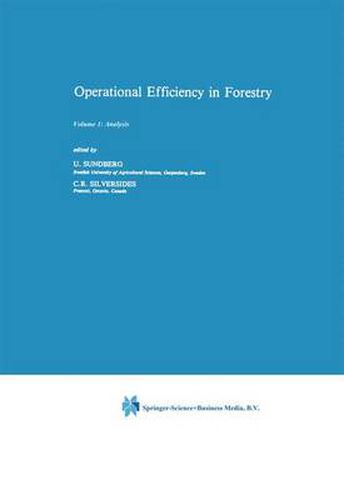Readings Newsletter
Become a Readings Member to make your shopping experience even easier.
Sign in or sign up for free!
You’re not far away from qualifying for FREE standard shipping within Australia
You’ve qualified for FREE standard shipping within Australia
The cart is loading…






This title is printed to order. This book may have been self-published. If so, we cannot guarantee the quality of the content. In the main most books will have gone through the editing process however some may not. We therefore suggest that you be aware of this before ordering this book. If in doubt check either the author or publisher’s details as we are unable to accept any returns unless they are faulty. Please contact us if you have any questions.
It is our conviction - based on many years of teaching and practical experience - that professional skill in forestry will develop more rea dily and more efficiently if forestry students are presented with a clear understanding, at an early stage, of the impact of the physical factors that both enhance and inhibit forestry activities. Tnis know ledge is best aquired by adressing the physical world of forestry with a set of analytical tools through which an almost infinite number of variables can be listed in order, be measured and their interaction be explored and resolved. This is the main purpose of this joint effort, presented in two volumes, Part I and Part II. Part I is analytic, written as a basic text for undergraduates in cour ses such as logging, transport, forest engineering and even forest ma nagement. It deals with the fundamentals of technology in forestry as determined by the physical environment. Briefly it can be visualized as the application of forestry wi thin the parameters: space, time and energy. Forestry is a process with a long time horizon. Free solar energy creates biomass which, with the aid of other forms of energy, is converted into products and services. A knowledge of the dependecies and interactions is indiGpensible for the forestry profession. The analytic approach serves two purposes: to bring about a clear un derstanding of the real world of forest and to develop tools through which efficiency and productivity can be explored and improved.
$9.00 standard shipping within Australia
FREE standard shipping within Australia for orders over $100.00
Express & International shipping calculated at checkout
This title is printed to order. This book may have been self-published. If so, we cannot guarantee the quality of the content. In the main most books will have gone through the editing process however some may not. We therefore suggest that you be aware of this before ordering this book. If in doubt check either the author or publisher’s details as we are unable to accept any returns unless they are faulty. Please contact us if you have any questions.
It is our conviction - based on many years of teaching and practical experience - that professional skill in forestry will develop more rea dily and more efficiently if forestry students are presented with a clear understanding, at an early stage, of the impact of the physical factors that both enhance and inhibit forestry activities. Tnis know ledge is best aquired by adressing the physical world of forestry with a set of analytical tools through which an almost infinite number of variables can be listed in order, be measured and their interaction be explored and resolved. This is the main purpose of this joint effort, presented in two volumes, Part I and Part II. Part I is analytic, written as a basic text for undergraduates in cour ses such as logging, transport, forest engineering and even forest ma nagement. It deals with the fundamentals of technology in forestry as determined by the physical environment. Briefly it can be visualized as the application of forestry wi thin the parameters: space, time and energy. Forestry is a process with a long time horizon. Free solar energy creates biomass which, with the aid of other forms of energy, is converted into products and services. A knowledge of the dependecies and interactions is indiGpensible for the forestry profession. The analytic approach serves two purposes: to bring about a clear un derstanding of the real world of forest and to develop tools through which efficiency and productivity can be explored and improved.